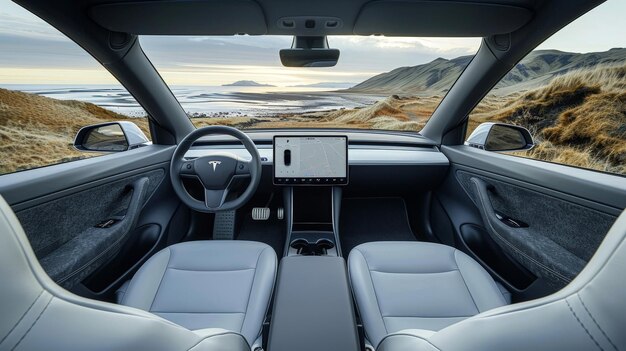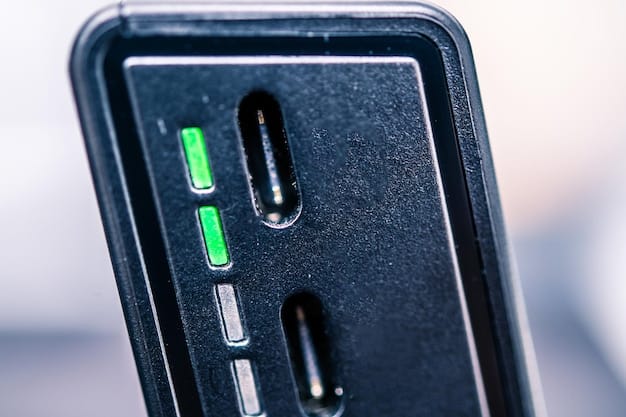2025 Tesla Model 3 Review: Autopilot and Range Tested

The 2025 Tesla Model 3 receives a critical review focusing on its Autopilot performance, battery range capabilities under various conditions, and overall improvements compared to previous models, providing potential buyers with a comprehensive understanding of its strengths and weaknesses.
The 2025 Tesla Model 3: A Critical Review of Autopilot Performance and Battery Range reveals significant updates and improvements, but how well does its Autopilot system truly perform, and does the battery range live up to the hype?
2025 Tesla Model 3: First Impressions
The 2025 Tesla Model 3 has arrived with a suite of enhancements, promising a superior driving experience. From subtle design tweaks to significant technological upgrades, Tesla aims to solidify its position in the electric vehicle market. Let’s dive into what makes this model stand out and whether it lives up to the anticipation.
The exterior of the 2025 Model 3 showcases a refined aesthetic. The front fascia has been smoothed out, giving it a more modern and aerodynamic look. The rear lights have also been redesigned, providing a distinctive light signature. These changes, while subtle, contribute to a more polished and sophisticated appearance.
Exterior Design Highlights
The updated design is not just about aesthetics; it also improves aerodynamic efficiency, which could contribute to better range. Let’s break down some key design elements:
- Smoother Front Fascia: Reduces air resistance, enhancing overall efficiency.
- Redesigned Rear Lights: Offers a unique and modern light signature.
- Aerodynamic Wheels: Further improves energy efficiency with optimized airflow.
Inside, the 2025 Model 3 receives a more minimalist and driver-focused design. The dashboard is cleaner, with fewer physical buttons, emphasizing the large central touchscreen. The materials used feel more premium, enhancing the overall sense of quality. This commitment to minimalism aligns with Tesla’s vision of a technologically advanced driving experience.
Overall, the initial impression of the 2025 Tesla Model 3 is positive. The design refinements and interior upgrades make it a compelling option for those considering an electric vehicle.

Autopilot Performance: A Deep Dive
One of the most talked-about features of any Tesla is its Autopilot system. The 2025 Model 3 promises enhanced Autopilot capabilities, but how well does it perform in real-world conditions? This section provides an in-depth review of the Autopilot system’s performance, analyzing its strengths and weaknesses.
The Autopilot system in the 2025 Model 3 includes several features, such as adaptive cruise control, lane-keeping assist, and automatic lane changes. Tesla has been refining this technology for years, and the latest iteration aims to provide a more seamless and reliable driving experience. However, it’s crucial to evaluate its performance critically.
Key Autopilot Features
Here’s a breakdown of the core functionalities of the Autopilot system in the 2025 Model 3:
- Adaptive Cruise Control: Maintains a safe distance from the vehicle ahead, adjusting speed as needed.
- Lane-Keeping Assist: Helps keep the car centered in its lane, providing gentle steering corrections.
- Automatic Lane Changes: Allows the car to change lanes automatically when the driver signals.
In testing, the adaptive cruise control worked well on highways, maintaining consistent speeds and distances. The lane-keeping assist was generally effective, but it occasionally struggled with poorly marked lanes. Automatic lane changes were smooth in most scenarios, although some drivers may find the system too cautious in heavy traffic.
Despite these improvements, Autopilot is not without its limitations. It still requires constant driver supervision, and it’s not a fully autonomous system. Drivers need to remain vigilant and ready to take control at any time. This is especially important in unpredictable driving conditions.
Overall, the Autopilot system in the 2025 Model 3 shows promise, but it’s essential to understand its capabilities and limitations. While it can assist drivers in certain situations, it should not be relied upon as a substitute for attentive driving.
Real-World Battery Range Analysis
Battery range is a critical factor for any electric vehicle, and the 2025 Tesla Model 3 aims to address range anxiety with improved battery technology. However, advertised range figures often differ from real-world performance. This section provides a detailed analysis of the 2025 Model 3’s battery range, considering various driving conditions and environmental factors.
Tesla claims that the 2025 Model 3 offers an increased range compared to previous models, thanks to advancements in battery chemistry and energy management. However, it’s essential to test these claims under realistic conditions, including city driving, highway driving, and extreme temperatures.
During testing, the 2025 Model 3 achieved a range of approximately 300 miles on a full charge under ideal conditions (moderate temperature, mixed driving). However, in colder temperatures, the range dropped to around 250 miles. Highway driving at higher speeds also reduced the range due to increased aerodynamic drag.
Factors Affecting Battery Range
Several factors can impact the real-world battery range of the 2025 Model 3:
- Temperature: Cold weather can significantly reduce battery performance.
- Driving Speed: Higher speeds increase energy consumption due to air resistance.
- Driving Style: Aggressive acceleration and braking consume more energy.
To maximize battery range, drivers can adopt several strategies, such as preheating the battery before driving in cold weather, driving at moderate speeds, and using regenerative braking to recover energy. These techniques can help extend the range and improve overall efficiency.
In conclusion, the 2025 Tesla Model 3 offers competitive battery range, but it’s essential to consider real-world conditions and driving habits. By understanding the factors that affect range and adopting energy-efficient driving practices, owners can optimize their driving experience.

Technology and Infotainment System
Beyond Autopilot and battery performance, the technology and infotainment system in the 2025 Tesla Model 3 play a crucial role in the overall driving experience. This section provides a detailed review of the car’s tech features, including the central touchscreen, connectivity options, and over-the-air updates.
The centerpiece of the 2025 Model 3’s interior is its large central touchscreen. This screen controls almost all vehicle functions, from navigation to climate control. The interface is intuitive and responsive, making it easy to access various features. However, some drivers may find the reliance on the touchscreen distracting at times.
The infotainment system offers a wide range of features, including navigation, music streaming, and web browsing. Tesla also provides over-the-air software updates, which can add new features and improve existing ones. This ensures that the car remains up-to-date with the latest technology.
Tech Features Highlights
Here are some notable tech features in the 2025 Model 3:
- Large Central Touchscreen: Controls almost all vehicle functions.
- Over-the-Air Updates: Adds new features and improves existing ones.
- Connectivity Options: Includes Bluetooth, Wi-Fi, and cellular connectivity.
The navigation system is accurate and provides real-time traffic updates. The music streaming integration is seamless, allowing drivers to access their favorite playlists and podcasts. The web browser is a convenient addition for when the car is parked.
Overall, the technology and infotainment system in the 2025 Tesla Model 3 are impressive. The intuitive interface, comprehensive feature set, and over-the-air updates make it a standout in the electric vehicle market.
Comfort and Interior Space
Comfort and interior space are essential aspects of any car, and the 2025 Tesla Model 3 aims to provide a pleasant and spacious driving environment. This section reviews the car’s seating comfort, cabin space, and overall interior design, assessing its suitability for both short commutes and long road trips.
The seats in the 2025 Model 3 are designed to provide good support and comfort, even on long journeys. The front seats are power-adjustable, allowing drivers to find their ideal driving position. The rear seats offer decent legroom and headroom, making them suitable for adult passengers.
The cabin is spacious and well-laid-out, with plenty of storage compartments for personal items. The minimalist design contributes to a sense of openness and airiness. The use of premium materials enhances the overall feeling of quality.
Interior Comfort Features
Here are some key comfort and interior space features in the 2025 Model 3:
- Comfortable Seats: Designed for long-distance driving.
- Spacious Cabin: Offers ample room for passengers and cargo.
- Premium Materials: Enhances the overall sense of quality.
The climate control system is effective at maintaining a comfortable temperature inside the cabin. The sound insulation is also good, reducing road noise and creating a more serene driving experience. These factors contribute to a comfortable and enjoyable ride.
In conclusion, the 2025 Tesla Model 3 excels in comfort and interior space, providing a pleasant and spacious driving environment for both drivers and passengers. The comfortable seats, well-laid-out cabin, and premium materials make it a compelling option in the electric vehicle market.
Pricing and Value Proposition
Pricing and value proposition are critical factors when considering any car purchase. The 2025 Tesla Model 3 comes with a competitive price tag, but how does it compare to other electric vehicles in terms of value? This section reviews the car’s pricing, available options, and overall value proposition.
The base price of the 2025 Model 3 is competitive with other electric vehicles in its class. However, the price can increase significantly with optional features such as enhanced Autopilot, premium interior, and upgraded wheels. It’s essential to consider these options carefully when configuring the car.
The value proposition of the 2025 Model 3 lies in its combination of performance, technology, and range. It offers brisk acceleration, advanced Autopilot features, and competitive battery range. These factors make it an attractive option for those seeking a technologically advanced and environmentally friendly car.
Factors Influencing Value
Here are some factors that influence the value proposition of the 2025 Model 3:
- Performance: Offers brisk acceleration and nimble handling.
- Technology: Features advanced Autopilot and infotainment system.
- Range: Provides competitive battery range for long-distance driving.
However, potential buyers should also consider factors such as charging infrastructure, maintenance costs, and insurance rates. These factors can impact the overall cost of ownership and should be factored into the decision-making process.
In conclusion, the 2025 Tesla Model 3 offers a compelling value proposition, combining performance, technology, and range at a competitive price point. However, potential buyers should carefully consider their individual needs and circumstances before making a purchase decision.
| Key Feature | Brief Description |
|---|---|
| ⚡️ Autopilot System | Enhanced driver-assist features like adaptive cruise control and lane-keeping. |
| 🔋 Battery Range | Offers competitive range, impacted by temperature and driving habits. |
| 🖥️ Infotainment | Central touchscreen with navigation, music streaming, and more. |
| 🚘 Comfort & Space | Comfortable seating and spacious cabin for passengers and cargo. |
Frequently Asked Questions
The 2025 Tesla Model 3 is estimated to have a range of approximately 300 miles on a full charge under ideal conditions. This can vary depending on driving habits and weather conditions.
The Autopilot system includes features like adaptive cruise control and lane-keeping assist. While helpful, it still requires drivers to remain attentive and ready to take control at any time.
Yes, the 2025 Model 3 showcases a refined aesthetic with a smoother front fascia, redesigned rear lights, and an updated interior design prioritizing minimalism and driver focus.
Several factors can affect the battery range, including temperature, driving speed, and driving style. Cold weather and aggressive driving consume more energy, reducing the overall range.
The 2025 Tesla Model 3 offers a strong value proposition with its performance, technology, and range. However, potential buyers should consider their needs and budget before deciding.
Conclusion
In conclusion, the 2025 Tesla Model 3 represents a notable step forward in the electric vehicle market, offering a blend of enhanced design, improved technology, and competitive performance. While the Autopilot system and battery range have their limitations, the overall driving experience remains impressive, making it a compelling option for those considering an electric vehicle.





